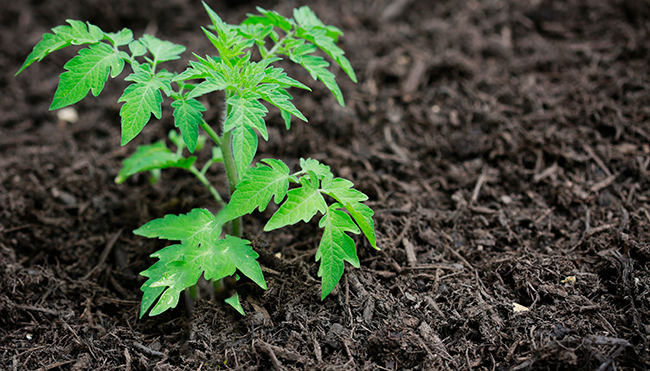A good harvest starts with optimal planting. Here are some tips for planting your tomatoes outdoors ... and making your garden friends, blush!
When and where to plant your tomatoes
- Toward mid-May, or after the last spring frost, it is time to plant your tomato seedlings outside.
- Choose a sunny location - a minimum 6 to 8 hours of sunlight per day - sheltered from the wind.
- Acclimatize your plants by taking them outside for a few hours at first, then longer every day.
 In open ground
In open ground
Tomatoes thrive in soil with a high humus content that is light and well-drained, and ideally fertilized before planting. Plant tomatoes in the vegetable garden or integrate them into your flowerbeds; they are as decorative as they are delicious!
- Dig generous holes. Plants should be spaced 50 to 60 cm apart.
- Put two big scoops of compost at the bottom of each hole.
- Water thoroughly.
- Place the plant in the hole and fill with earth halfway up the plant. Tomato plants have the peculiarity of developing roots all along the stem when buried in earth.
- Water again thoroughly, taking care not to moisten the leaves.
- If there are flowers or small fruit on your plant, remove them in order to encourage root development first.
- Put a 5 to 10 cm layer of straw around each plant to conserve soil moisture.
- Insert a clean and disinfected 1.5 m stake to support the plant.
- If you are planting rows of tomatoes, leave 80 cm between rows.
- In the vegetable garden, tomato plants do well alongside carrots, celery, cucumbers, onions, garlic, peppers, asparagus, radishes, mint, basil, parsley, sage and rosemary. Avoid planting your tomatoes next to cabbage, fennel, corn, beets, peas and potatoes.
 In containers
In containers
Tomato plants do very well in rich, well-drained soil, which makes them suited to container growing, even on small balconies. A 60-litre container will be sufficient. Plants need to be sheltered from the wind in a location with lots of sunlight. Opt for determinate, compact bush varieties; indeterminate varieties, which are more robust and grow much higher, require a greater volume of earth than most containers can provide.
- Plastic or terra cotta containers: Darker coloured pots are preferable since they attract sunlight and the substrate will retain heat. Make sure there is a hole at the bottom so that water can drain.
- Containers with a water reserve and watering spike: These pots are ideal for plants requiring a great deal of water, such as tomatoes. The water reserves mean you can skip some watering, and the plants can make it through a heat wave.
- Smart Pots: Smart Pots are durable fabric containers ideal for growing everything just about anywhere. The geotextile bag allows roots to breathe and favours root aeration. Smart Pots promote root development.
- Thoroughly water the root balls of your plants.
- Wash and disinfect pots.
- In plastic and terra cotta containers, put a layer of gravel in the bottom to promote drainage. Containers with water reserves and Smart Pots do not require gravel.
- Tomatoes are nutrient-greedy plants, so fill containers with a mix of compost and soil rich in organic matter.
- Make a deep hole and add a fistful of tomato fertilizer. Insert the plant at an angle to cover a good part of the stem. Fill with soil. One tomato plant per container.
- Water thoroughly.
- If there are flowers or small fruit on your plant, remove them in order to encourage root development.
- Insert a stake.
- For pot companions, plant a few herbs or marigolds with the tomato plant. Basil seems to enhance the flavour of tomatoes.




